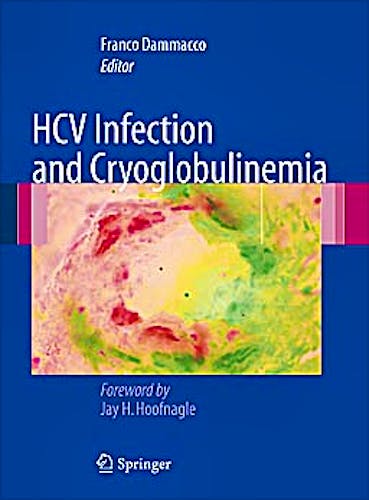

There are no products in the cart.



Hcv Infection and Cryoglobulinemia
Dammacco, F.
1ª Edition December 2011
English
Hard Cover
350 pags
1000 gr
19 x 26 x null cm
ISBN 9788847017047
Publisher SPRINGER
Printed Book
-5%
155,99 €148,19 €VAT included
149,99 €142,49 €VAT not included
Receive it within
2 - 3 weeks
In 1947 Lerner and Watson showed cold-precipitable proteins to be gammaglobulins and called them ‘cryoglobulins’ and the corresponding clinical condition ‘cryoglobulinemia’. Meltzer and Franklin in 1966 provided an accurate description of the typical clinical symptoms associated with cryoglobulinemia, showed that they consisted of two different globulin components and, because of the ignorance on its etiology, called this clinical condition ‘essential mixed cryoglobulinemia’. For almost 20 years progress has been rather slow in this field, but when at the end of the ‘80s it finally became possible to detect the occurrence in the serum of antibodies to the hepatitis C virus (HCV), many groups in Europe and the United States almost simultaneously reported that a high proportion of ‘essential’ cryoglobulinemias are in fact associated with HCV infection. This hallmark has resulted in a new impetus and great enthusiasm in carrying out new researches made possible by the awareness that cryoglobulinemia is to be considered an undisputable extrahepatic manifestation of HCV infection.
This book is indeed unique in the detail of its presentation, its completeness and its fundamental approach to the subject. The most qualified authors have been invited to contribute critical articles reviewing significant developments related to each of the sections in which the whole treatment has been divided.
The reader will appreciate the immediacy of style, the striking illustrations, and the color plates. In addition, the comprehensive review of a systemic disease such as cryoglobulinemia will interest basic scientists and specialists involved in several disciplines, including internal medicine, hepatology, hematology, oncology, infectious diseases, rheumatology, nephrology and dermatology. General practitioners, graduate and post-graduate students will also find in this book an irreplaceable source of update in this fascinating field.
Content Level » Professional/practitioner
Keywords » Autoimmunity - Cryoglobulinemia - HCV - Immune Complex Diseases
- Malignant Lymphoma
Related subjects » Internal Medicine - Oncology & Hematology - Rheumatology
TABLE OF CONTENTS
Hepatitis C Virus infection and the role of the immune system: Natural history, pathogenesis, and prevention of HCV infection. Interactions between HCV and the immune system. Molecular characterization of B cell clonal expansion in chronic HCV-infected patients.- Cryoglobulinemia: Immunochemical Characterization, Serological Abnormalities and Histopathological Changes: Classification and serological studies of cryoglobulins. The complement system in cryoglobulinemia. The role of gC1q-R/p33 in infection and inflammation. The pivotal role of C1q-R in mixed cryoglobulinemia. Autoimmune phenomena in HCV-positive patients with mixed cryoglobulinemia. Histopathology of various tissues in cryoglobulinemic patients.- Structural and Genetic Features, Cytokines and Chemokines In Cryoglobulinemia: Mixed cryoglobulinemia cross-reactive idiotypes: structural and clinical significance. Genetic insights into the disease mechanisms of type II mixed cryoglobulinemia. The role of vascular cell adhesion molecule-1 (VCAM-1) in the pathogenesis of vasculitis associated with mixed cryoglobulinemia. Upregulation of B-lymphocyte stimulator (BLyS) in patients with mixed cryoglobulinemia. B cell deregulation in cryoglobulinemia and the role of chemokines. Alpha-chemokine CXCL10 and beta-chemokine CCL2 serum levels in HCV-positive cryoglobulinemia.- Cellular Compartments of HCV Infection (and Replication): Mechanisms of cell entry of hepatitis C virus. Infection of dendritic and liver cells. Infection of perihepatic lymph nodes and peripheral blood mononuclear cells. Infection of hematopoietic cells. Infection of the skin, renal tissue and gastric mucosa.- Mechanism(s) of Cryoprecipitation: Proteome analysis of cryoglobulins by resonance mass spectrometry.- Clinical Manifestations of Cryoglobulinemia: Experimental model(s) of mixed cryoglobulinemia. Cryoglobulinemia and chronic HCV infection: an evolving story. Demographic and survival studies of cryoglobulinemic patients. The expanding spectrum of clinical features in HCV-related mixed cryoglobulinemia. A national survey of clinical features in the cryoglobulinemic syndrome. HCV-associated membranoproliferative glomerulonephritis. Rheumatologic symptoms in patients with mixed cryoglobulinemia. Endocrine manifestations of HCV-positive cryoglobulinemia. Cryoglobulinemic cutaneous vasculitis. Central nervous system involvement and peripheral neuropathy in cryoglobulinemia. Long-term course of patients with mixed cryoglobulinemia. Clinical and immunological features of HCV/HBV co-infected patients with mixed cryoglobulinemia. Clinical and immunological features of HCV/HIV co-infected patients with mixed cryoglobulinemia. HCV-negative mixed cryoglobulinemia: facts and fancies. Cryoglobulinemia in HCV-positive renal transplant and liver transplant patients.- HCV Infection, Cryoglobulinemia and Non-Hodgkin’s Lymphomas: Chromosome abnormalities in HCV-related lymphoproliferation. Molecular features of lymphoproliferation in mixed cryoglobulinemia. HCV infection, cryoglobulinemia and splenic lymphoma with villous lymphocytes: a serendipitous coincidence or a new entity? Incidence and characteristics of non-Hodgkin’s lymphomas in a multicenter case file of HCV-positive patients with mixed cryoglobulinemia. HCV-positive patients, with or without cryoglobulinemia, show a higher prevalence of B-cell non-Hodgkin’s lymphoma. HCV-positive patients, with or without cryoglobulinemia, are not more susceptible to B-cell non-Hodgkin’s lymphoma. Waldenström’s macroglobulinemia associated to cryoglobulinemia: pathogenetic, clinical and therapeutic aspects.- Therapy of Cryoglobulinemia: Should HCV-positive asymptomatic patients with mixed cryoglobulinemia be treated with combined antiviral therapy? The role of Rituximab in the therapy of mixed cryoglobulinemia. Should the use of Rituximab be restricted to refractory and relapsing patients with cryoglobulinemic vasculitis? PIRR therapy in HCV-related mixed cryoglobulinemia. Active or indolent cutaneous ulcers in cryoglobulinemia: how should they be treated. Double filtration plasmapheresis: an effective, symptomatic treatment of cryoglobulinemia. Therapeutic approach to emergency in cryoglobulinemia. Relapse of anti-HCV-positive mixed cryoglobulinemia in patients with sustained viral response. Novel therapeutic approaches to cryoglobulinemia: Imatinib, Infliximab, Bortezomib and beyond.
© 2025 Axón Librería S.L.
2.149.0